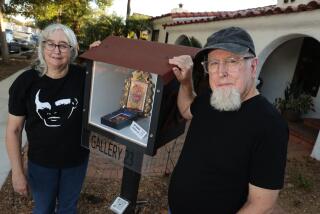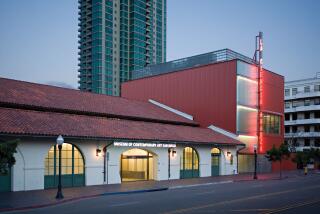Recycled Art Emerges From the Throwaway Culture
- Share via
John White believes that yard sales represent a lot more than just a culmination of someone’s old junk. In fact, White, who calls himself a “junior anthropologist” after spending more than six years “studying” the sales, has created an installation in homage to them.
“The yard sale or garage sale does have some social significance,” said White, whose installation, “Yard Sales,” is on view through Sunday at the USC Atelier in Santa Monica Place.
“It reflects on our society as a throwaway culture. Garage sales are a spinoff from our totally being dominated by advertising that tells us what to buy. So we buy it, and then we find out a lot of the stuff is of not much value or is no good, and we have to have an outlet to get rid of it.
“The attic used to be the place to keep things, but in California there are no attics,” he continued. “So through garage sales, people found a way to get it all out. And they’re getting money out of it. It’s like they’re saying, ‘At least I’m getting something back from this mistake I’ve made.’ ”
White, a Los Angeles artist known for his painting, sculpture and performance art, said he has attended 10 to 15 yard and garage sales every weekend for seven or eight years. It’s become a social activity for him and his wife and daughter, and has also become a major source of supplies (such as used paint and raw materials) for his art.
“I go to get ideas--there’s always something to buy at a yard sale that I can use for a sculpture,” White said, adding that he often buys items (such as broken toys, fishing poles and tennis balls), paints the objects black to “neutralize” them, and then uses them for something other than their intended use.
This is the first time, however, that White has produced a show focusing on the yard-sale theme.
White’s installation contains several components, not the least of which is a 300-piece sampling from his mammoth collection of signs advertising yard sales, garage sales, moving sales, getting-married sales, junk sales, estate sales, neighborhood sales and even divorce sales.
“It’s a charming form of primitive art,” White said, as he looked over the Atelier’s 18-by-36-foot south wall, which is covered with the signs. “It’s wonderful, the different styles that people come up with to advertise their sales. It’s amazing what they reflect about themselves and how they feel about their sales through their lettering and other decoration on the signs.”
White said that he’s amassed more than 1,000 signs during the three or four years he has been collecting them, and that his idea for the entire installation came out of a desire to show off those signs.
“I always wanted to show my yard-sale signs--like a collector shows his things,” White said. “It’s almost outrageous--my wife thinks I’m absolutely bananas anyway, as most people do when they hear I collect yard-sale signs. Nobody does it. It’s like collecting lint, but I do it.”
It is the signs, White says, that will draw people in to look at the rest of the exhibition: Jutting out from the wall opposite the signs is White’s reconstruction of a yard sale in progress. But the attempt is not to re-create the environment, he says, just to show the yard sale as White sees it. Along this line, the usual yard sale goods have been fixed up--either painted or bronzed, or “arranged in a kind of art context.”
Nearby are White’s wooden sculptures of telephone poles, which he has painted, rusted and adorned with nails and staples to show that “there’s a million things going on” in local neighborhoods. Next to these are close-up photographs of actual phone poles, focusing in on the “timelessness” represented by the staples and nails that have remained where countless signs and flyers once stood.
Also included is a seven-minute videotape that shows White’s interviews with local families as they put on their yard sales; a wall containing a series of notes highlighting and explaining items in his reconstructed yard sale, and an audio tape in which his wife, Sylvia White, reflects on the “throw-away culture” and “burgeoning underground economy” that produced the yard sale.
“This show is more for the general public than (any of my shows) before. Everyone can relate to this,” said White, who confessed that making his art accessible enough for a walk-in gallery in a shopping center has been a bit of a problem.
“This is a public forum . . . and it requires a different type of art. But I’m working with that in mind to see that it is accessible for more than just an art crowd.”






